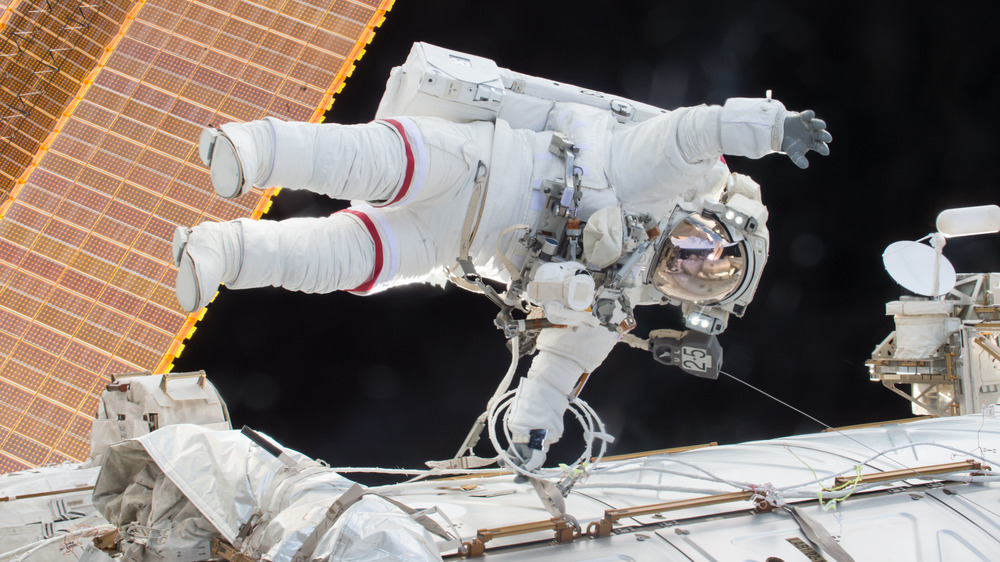The Truth About Spacewalks
According to Texas State University, which is a partner with NASA, astronauts on the International Space Station (ISS) have performed over 200 spacewalks in its more than two decades of operation. And the administration has a lot more planned as it sets its sights once again on putting humans on the moon, a goal it hopes to achieve by 2028. Spacewalks are absolutely integral to the progress of human space exploration, so let's take a look at exactly what spacewalks are, how astronauts get ready for them, and how they're carried out.
According to NASA, the first-ever spacewalk was performed by Russian cosmonaut Alexei Leonov on March 18, 1965, a stroll through space that lasted only 10 minutes. A Russian cosmonaut also holds the record for the most spacewalks, with 16. Anatoly Solovyev has spent over 82 hours on spacewalks.
Astronaut Ed White was the first American to take a spacewalk. A member of the Gemini 4 crew, he took his 23-minute stroll on June 3, 1965. Among American astronauts, four share the country's record of 10 walks each. Those astronauts are Peggy Whitson, Chris Cassidy, Michael Lopez-Alegria, and Bob Behnken. Among the four, Lopez-Alegria, with 67 total hours, has spent the most time walking in space. Spacewalks today range anywhere from five to eight hours, depending on the reason for exiting the space station.
The how and why of spacewalks
NASA calls spacewalks extravehicular activity, or EVA. There are several reasons why astronauts suit up and carry out these incredible missions.
Like any vehicle, spacecraft need regular maintenance and repairs. Another reason is to perform experiments. Astronauts go outside of the spacecraft to leave experiments on the exterior of the ship in order to observe the effects the vacuum of space has on various objects. They also do spacewalks when a passing satellite needs fixing up, as this is easier than bringing the equipment back down to Earth for repairs.
There are three types of spacewalks that astronauts perform on the ISS. There are those that are planned beforehand, scheduled into the missions. There are unscheduled walks that arise when unplanned repairs are needed. Then there are what are called contingency spacewalks, which are urgent unscheduled walks that must be carried out quickly to deal with threats to the safety of the astronauts and the ISS.
Although a spacewalk lasts at most eight hours, the whole process takes an entire day of the astronauts' time. They have to put on their spacesuits, or extravehicular mobility units (EMUs), for several hours before exiting the station. This gives them time to pressurize and takes the nitrogen out of their bodies. If they don't do this, bubbles will form in their blood, a condition called the bends. Scuba divers on Earth are also in danger of getting the bends if they surface too quickly from a deep dive.
What it's like to be on a spacewalk
Astronauts exit the space station via an airlock. The astronaut enters the pressurized airlock, which is then sealed off from the spaceship, and then the pressure decreases. Once this process is complete, the astronaut is ready to exit the space station. Spacewalking astronauts are attached to the ship with a 55-foot tether so they don't float away. Tools are also tethered to their EMUs for this same reason. Their spacesuits are equipped with two different kinds of thruster units to allow them to maneuver better in space. This can also help them get back to the space station in the unfortunate event that their tethers become disconnected.
We know what you're thinking: What happens if nature calls during the spacewalk? Going to the bathroom in the space station is no easy task, and doing it in the spacesuit is no cakewalk, either. According to How Stuff Works, to take care of business on a spacewalk, astronauts wear a Maximum Absorption Garment — basically, a diaper — which is disposed of after the walk. If they get hungry, a slot in the suit will feed them a cereal bar with fruit, and they can drink from a straw connected to an In-suit Drink Bag when they get thirsty. However, most astronauts prefer to not be bothered by hunger on their spacewalks and eat beforehand, so as to give all their attention to the task at hand.


